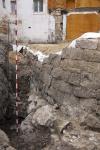Summary (English)
The archaeological intervention carried out in Rúa Mayor Street brought to light essential remains from the pre-Roman Age at the site. It began as simple archaeological supervision for work being done to change the structural foundation of the building’s façade. The opening and layout of this street date from the end of the 19th century. Therefore, the archaeological works were carried out in observance of the municipal laws.
The excavated site occupies a total floor area of 410 square metres. Preliminary coring undertaken in 2010 showed strong ash levels; subsequently certain architectural structures were identified with associated materials linked to the Celtiberian world. By order of the local government, the archaeological works were extended with area excavations that revealed three occupation periods subdivided into seven phases.
Twenty-four square metres of the surface subject to the intervention correspond to the excavated area of the Sector A ash heap, located in the southern area. The remains of Bronze Age walls spread over 70 square metres located in the western half of the site and a defensive structure with North-South direction was identified there. The best-kept remains of this structure measure 14.20 × 8.80 metres at maximum width and occupy an area of approximately 70 square metres. This was one of the gates to the old oppidum of Salmantica, built at the end of the Second Iron Age and later Romanised. Some experts consulted believe it could be what was known as Hannibal’s Gate, in memory of the Helmantiké conquests made by the Carthaginian general.
This fortress structure would have been sealed by deep ash and filling levels at some indeterminate time during Late Antiquity. In any case, the structure found is similar to those known from the Salmantinian castro at Yecla de Yeltes and can be dated around the 4th century BC. This was followed by a long period of crisis and the reformulation of the local castro culture characterised by marked Celtiberianisation and subsequent Romanization.
These important findings permit a rethinking of urban development for the early settlements in Salamanca. The inventoried materials prove the general interpretation of the site and confirm the abandonment and sealing off of the castro settlement in Late Antiquity; the subsequent occupation, much more recent, ranges from the end of the Modern Age to the Contemporary Age.
The proposal for corrective measures is aimed at protecting this outstanding heritage at all costs; in this regard, owing to its nature, it deserves the same protection as a Heritage of Cultural Interest.
- Elvira Sánchez Sánchez
Director
- Elvira Sánchez Sánchez (ADOBE, Gestión de Patrimonio Histórico, SL)
Team
- Rosa Moreno Pelayo
- Dolores Torrero
- Mª Dolores Gómez y Claudio Francisco Prieto Ramos
- Francisco Carbonero
- David Arraz
- Arsenio Dacosta
Research Body
- ADOBE, Gestión de Patrimonio Histórico, SL; Junta de Castilla y León, Consejería de Cultura y Turismo, Dirección General de Patrimonio y Bienes Culturales
Funding Body
- Financiación privada. Empresa PALCO-3, SL






![Download [PDF]](/excavation/skins/fasti/images/results/download_sml.png)

